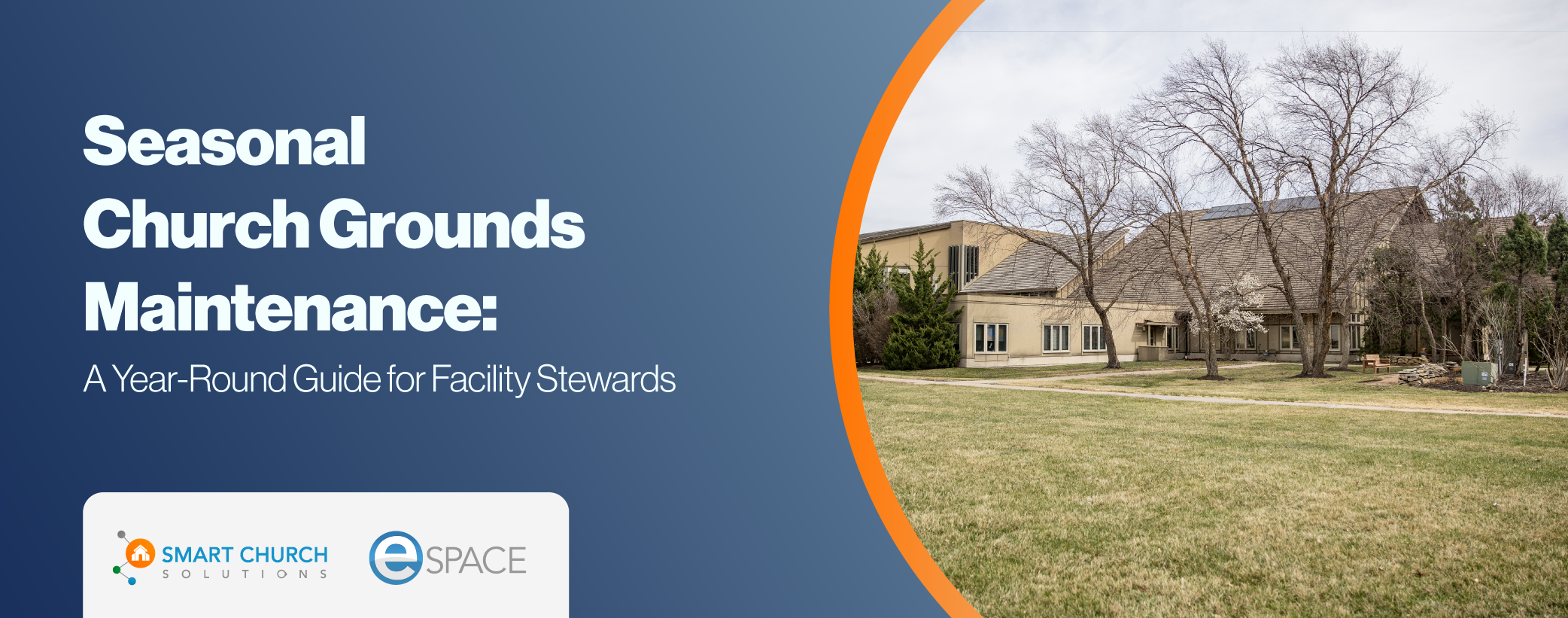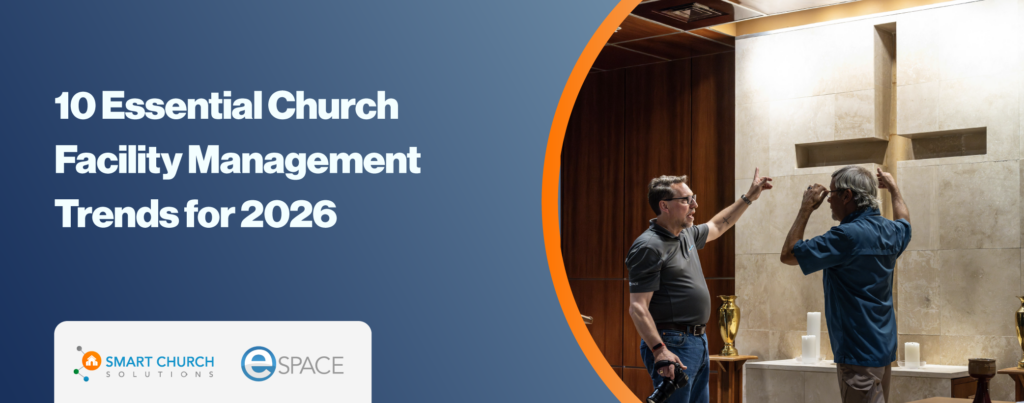When it comes to maintaining a church campus, exterior upkeep is just as important as what happens inside the building. Seasonal shifts bring unique challenges that can impact everything from curb appeal to safety and operational efficiency.
This comprehensive guide outlines the most important seasonal church grounds maintenance tasks, helping facility managers and operations teams stay one step ahead all year long.
Why Seasonal Grounds Maintenance Matters
Facility stewardship isn’t a one-and-done task—it’s an ongoing responsibility that changes with the weather, the calendar, and the needs of your congregation. By following a seasonal approach, churches can:
- Prevent costly damage to landscaping and hardscapes
- Reduce safety risks from falling limbs or icy walkways
- Improve first impressions for guests and members
- Extend the life of trees, shrubs, and infrastructure
- Maintain compliance with insurance and regulatory expectations
Let’s break grounds maintenance down by season in the following paragraphs.
Spring: Set the Foundation for the Year
Spring is a critical setup season. Use this time to inspect, repair, and refresh before summer activities ramp up.
- Inspect and Repair Irrigation Systems
- Schedule a full inspection of your backflow preventers and sprinkler systems
- Repair broken sprinkler heads, leaking lines, or timers damaged by winter
- Refresh Landscaping
- Trim bushes and trees—especially near buildings or high-wind areas
- Remove dead limbs to reduce storm damage
- Refresh flower beds with new mulch and seasonal plantings
- Apply pre-emergent weed control early to suppress growth
- Clean Exterior Systems
- Check gutters, downspouts, and underground drainage for blockages
- Power wash walkways, parking lots, and building exteriors
- Inspect and service exterior faucets (look for leaks or corrosion
- Prepare for Outdoor Activity
- Clean and inspect outdoor seating, grills, and playgrounds
- Refill and safely store propane tanks for summer use
Summer: Monitor, Maintain, and Manage Activity
Summer brings increased activity—and with it, more wear and tear.
- Manage Irrigation Carefully
- Adjust irrigation timers for early morning cycles (avoid afternoon watering)
- Monitor for soggy patches, runoff, or malfunctioning zones
- Work with local experts to tailor your watering schedule to your climate and turf type
- Increase Cleaning and Pest Control
- Clean trash cans more frequently (sticky mess = more pests)
- Watch for stinging insects like wasps around playgrounds and eaves
- Ensure outdoor hydration stations and water jugs are cleaned regularly
- Prepare for Outdoor Events
- Monitor and maintain areas used for bounce houses, slip-n-slides, or tents
- Reseed or restore lawn areas damaged by recurring traffic
- Make sure outdoor fire extinguishers are accessible and properly rated
- Care for Your Team
- Encourage hydration and sun protection for volunteers and staff
- Schedule shade breaks and rotate tasks during high-heat hours
Fall: Clean Up and Plan Ahead
Fall is both a clean-up season and a planning season. Use this time to evaluate your summer success and prepare for the colder months.
- Landscape Review and Removal
- Identify plants or turf that didn’t survive the summer heat
- Work with local nurseries or extension offices to select drought-tolerant replacements
- Remove annuals and prep flower beds for seasonal replanting
- Tree and Shrub Maintenance
- Trim back overgrown branches or trees at risk of winter storm damage
- Remove fallen leaves and debris from gutters and roof drains
- Reassess plant health and update your lifecycle replacement plan
- 💡 Pro Tip: Use a lifecycle calculator to track the expected life of your trees and shrubs—especially if you’re budgeting for future replacements.
- Prep for Winter Weather
- Weatherproof outdoor faucets and backflows
- Blow out sprinkler lines if your region experiences freezing temperatures
- Place small heaters in exterior-only mechanical rooms to prevent pipe bursts
- Order Winter Supplies Early
- Stock up on ice melt and place buckets near high-risk areas
- Do another roof and gutter inspection before snow or heavy rain
- Install seasonal signage or lighting while the weather is still mild
Winter: Monitor, Maintain, and Mitigate Risk
Winter maintenance isn’t just about snow—it’s about identifying problem areas, staging equipment, and preventing accidents.
- Monitor Ice and Drainage
- Walk the campus to check for puddles or runoff that refreeze overnight
- Note areas where ice forms repeatedly and place signage or pre-stage salt
- Maintain Clear Access
- Ensure snow removal or de-icing is scheduled and budgeted
- Check for blocked drains or gutters that could overflow during thaws
- Pre-Stage Equipment
- Keep salt, shovels, and snow blowers near entry points
- Verify that safety supplies are accessible to custodial staff and volunteers
Budgeting for Grounds Maintenance
Don’t forget to allocate funds for seasonal exterior maintenance in your church’s budget. This is one of the most commonly overlooked line items until issues become costly or urgent. As a general rule of thumb, plan to budget approximately $6,000 to $7,000 per developed acre per year. Developed acreage includes all areas that require regular upkeep—such as landscaping, playgrounds, sports fields, and walkways.
Keep in mind that features like synthetic sports turf, detention ponds, and playground mulch can significantly increase maintenance costs. On the other hand, incorporating native plantings and low-maintenance landscape designs can help reduce expenses over time.
Bonus Tip: Seasonal Plant Swaps
Some churches rotate flower bed plantings throughout the year, like resorts or theme parks. If you’ve got a green-thumb volunteer team, consider:
- Swapping out plants each season for maximum visual appeal
- Removing dead plants before they become an eyesore
- Using nursery-ready plants for quick and easy upgrades
Final Thought: Stewardship Through Seasons
Grounds maintenance isn’t just about keeping things clean—it’s about stewarding the space God has entrusted to your church. Using the seasons as a built-in schedule ensures proactive care, smarter budgeting, and a more welcoming experience for your congregation and community.
Need Help Managing Church Maintenance Year-Round?
Smart Church Solutions provides powerful tools like eSPACE to help facility managers stay organized, proactive, and prepared for every season. Learn more about eSPACE and how we support churches in their facility stewardship journey.








